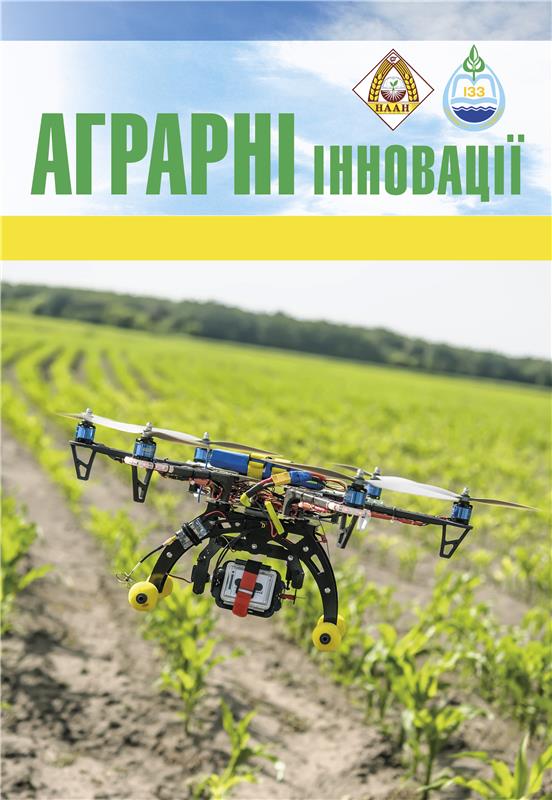THE INFLUENCE OF VARIETAL CHARACTERISTICS ON THE DURATION OF INTERPHASE AND VEGETATION PERIODS OF MEDICINAL HYSSOP
Abstract
Monitoring of phenological changes in the development of medicinal hyssop taking into account modern climate challenges is a relevant topic for research, since stress factors associated with climate changes significantly affect the productivity of medicinal hyssop. The purpose of the research was to investigate the formation of the yield of the green mass of medicinal hyssop with the use of biologically active fertilizers in the conditions of natural moistening of the Southern Steppe of Ukraine. Studies show that temperature fluctuations and changes in the level of atmospheric precipitation significantly change the development vector of hyssop, slowing down or accelerating certain phases of its life cycle. In this article, a comparative analysis of the reactions of different varieties of medicinal hyssop to climate change is carried out. The results. In the course of research, it was established that young medicinal hys- sop plants show a faster growth of vegetative mass, more actively form bushes and have a shorter period of flowering and seed ripening – from 5 to 13 days, compared to plants of the third year of life. However, plants of the 3rd year of life show better frost resistance, restore vegetation earlier and demonstrate increased resistance to dry conditions observed in 2024. This resistance of older plants is associated with the development of the bush and the presence of dormant buds, which contribute to their adaptation in stressful conditions. Studies of the duration of interphase and vegetation periods of medicinal hyssop confirm that the growth and development of this plant significantly depend on the complex influence of climatic conditions and biological specifications of varieties. Climatic factors, such as air temperature, rainfall play a decisive role in the adaptation of hyssop to specific environmental conditions, which, in turn, significantly affects its morphological characteristics and overall productivity. Conclusion. Thus, a comprehensive approach to the study of the influence of climatic and biological factors is necessary to understand the evolution of hyssop in the conditions of modern agricultural production.
References
2. Harvest and quality of hyssop (hyssopus officinalis L.) / C. Stan et al. Actual tasks on agricultural engineering : proceedings of the 47th international symposium (Opatija, 5-7 March 2019). Bucharest, 2019. P. 315–321. URL: https://www.cabidigitallibrary. org/doi/pdf/10.5555/20193202182.
3. Schnelle F. Pflanzen-Phänologie. Probleme der Bioklimatologie Bd. 3. Akadem. Verlagsges. Leipzig 1955. 299 S., 46 Abb., 14 Kart. Journal of Plant Nutrition and Soil Science. 1956. Vol. 73, no. 2. P. 156. DOI: https://doi.org/10.1002/jpln.19560730209.
4. Коваленко О., Абрамова В., Андрійченко Л. Продуктивності гісопу лікарського за умов краплинного зрошення в південному в степу України. Розвиток аграрної галузі та впровадження наукових досліджень у виробництво : матеріали міжнар. науково-практ. конф., м. Миколаїв, 17–19 жовт. 2018 р. Миколаїв : МНАУ, 2018. С. 7–9. URL: https://dspace. mnau.edu.ua/jspui/bitstream/123456789/9054/1/ zbirnyk_tez_18_7-9.pdf
5. Коваленко О. А. Елементи живлення гісопу лікарського за краплинного зрошення на Півдні України. Аграрні інновації. 2022. № 14. С. 51–59. DOI: https:// doi.org/10.32848/agrar.innov.2022.14.8.
6. Kovalenko O. A., Andreichenko L. V., Polyansky S. V. Influence of sowing dates, irrigation regimes and mineral fertilizers on the productivity of common hyssop. Education and science of today: intersectoral issues and development of sciences : proceedings of the III international scientific and practical conference (Cambridge, 20 May 2022). Cambridge-Vinnytsia : Publishing House & European Scientific Platform, 2022. P. 110–115. DOI: https://doi.org/10.36074/logos-20.05.2022.034.
7. Wesołowska A., Jadczak D., Grzeszczuk M. Essential oil composition of hyssop (Hyssopus officinalis L.) cultivated in north-western Poland. Herba polonica. 2010. Vol. 56, no. 1. P. 57–65. URL: https:// herbapolonica.pl/article/532819/en.
8. Добровольський П. А. Параметри продуктивності гісопу лікарського за вирощування в умовах південного Степу України. Таврійський науковий вісник. 2021. № 120. С. 36–42.
9. Коваленко О. А., Андрійченко Л. В. Як вирощувати нову пряно-ароматичну культуру гісоп лікарський у південній частині Степу України. The Ukrainian FARMER. 2019. № 2 (110). С. 122-123.
10. Ткачова Є. С., Федорчук М. І. Перспективи використання рослини гісопу лікарського. Інноваційні технології в рослинництві : матеріали III всеукр. наук. Інтернет-конф. (м. Ка́м'яне́ць-Поді́льський, 15 липня 2020 р.). Ка́м'яне́ць-Поді́льський, 2020. С. 118–120. URL: https://dspace.mnau.edu.ua/jspui/ handle/123456789/12120.
11. Методика проведення експертизи сортів рослин групи декоративних, лікарських та ефіроолійних, лісових на придатність до поширення в Україні / за ред. С. О. Ткачик ; уклад.: З. Б. Києнко та ін. Вінниця : ФОП Корзун Д. Ю., 2017. 129 с. URL: https://sops.gov. ua/uploads/page/5b7e660408703.pdf.
12. Tkachova Y. S., Fedorchuk M. I., Kovalenko O. A. The allelopathic activity of water-soluble biologically active substances from hyssopus officinalis L. of marquis varieties and their effect on the root growth of lepidium sativum L. Journal of organic and pharmaceutical chemistry. 2022. Vol. 20, no. 1(77). P. 44–50. DOI: https://doi.org/10.24959/ophcj.22.253471.
13. Judžentienė A. Hyssop (hyssopus officinalis L.) oils. Essential oils in food preservation, flavor and safety. 2016. P. 471–479. DOI: https://doi.org/10.1016/b978-0- 12-416641-7.00053-5.
14. Some agronomic characteristics and essential oil com- position of hyssop (hyssopus officinalis L.) under cultivation conditions / S. Kizil et al. Acta scientiarum polo-norum-hortorum cultus. 2016. Vol. 15, no. 6. P. 193–207.
15. The effect of irrigation treatment on the growth of lavender species in an extensive green roof system / A. T. Paraskevopoulou et al. Water. 2020. Vol. 12, no. 3. P. 863. DOI: https://doi.org/10.3390/w12030863.
16. Salachna P. Depolymerised sodium alginate as a eco-friendly biostimulant for improving herb yield and nutrient accumulation in hyssop. Journal of ecological engineering. 2023. Vol. 24, no. 9. P. 105–111. URL: https://doi.org/10.12911/22998993/168553.






